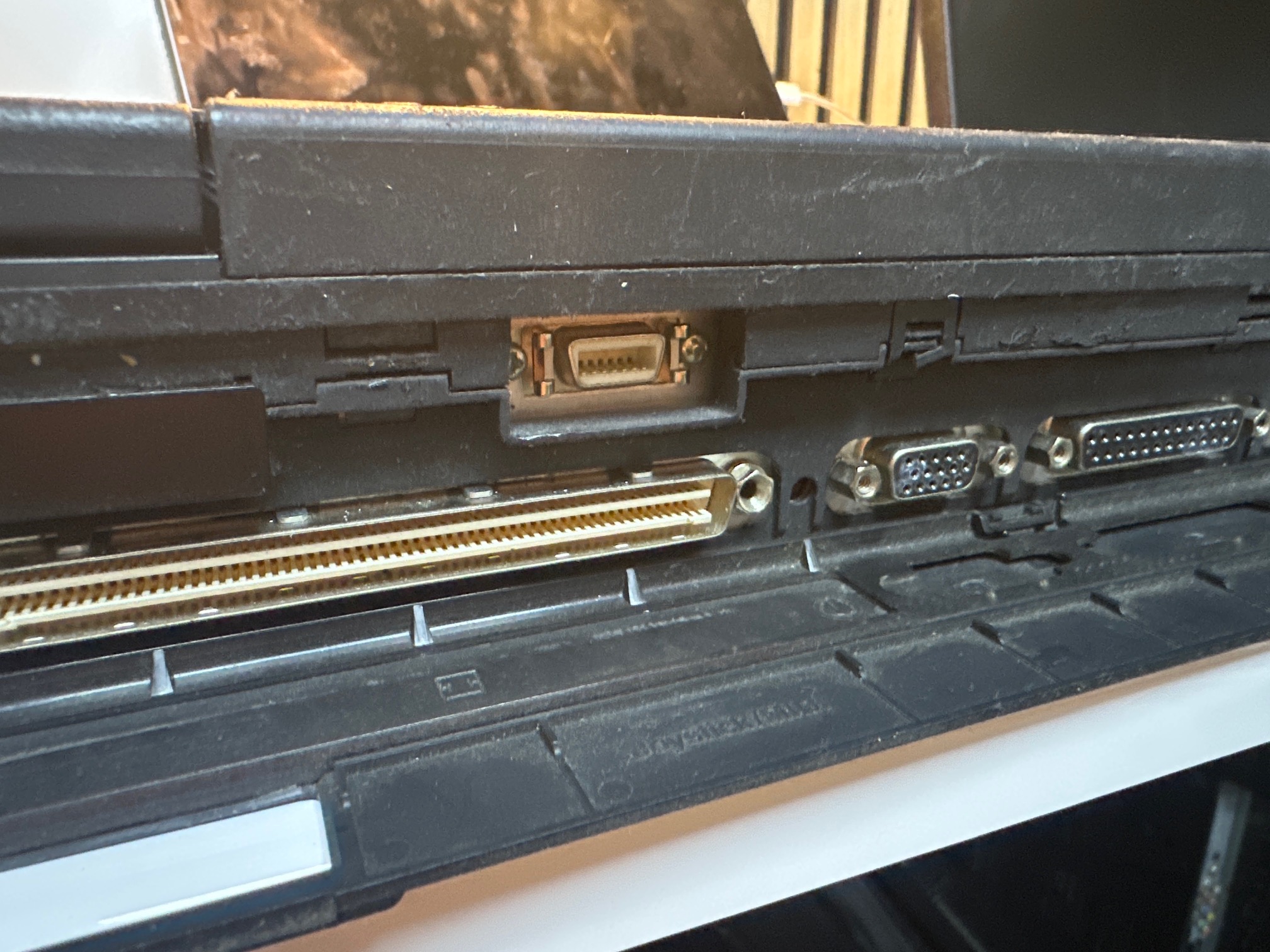I originally intended to spend the morning finishing restoring a Pentium 75 Thinkpad 755CD which has been 'on the shelf' for about 2 years with an on-board 00201 memory issue. It ended up taking exactly 12 hours even after last night I'd already dismantled and resolved the issue with the memory.
The 755CD is quite different from all the other 755 machines because it is a fatter chassis - to incorporate the CD-ROM drive and, I think more so the massive video and digital sound processing hardware that accompanied this 'multimedia' expansion. Due to the battery and HDD being standard across all 755 machines, the 755CD has a plastic 'spacer on a hinge above these two bits, to keep everything in place.
The 486 755CD and 486 CE were released in October 1994, the Pentium CX, 486 CV and 486 CDV were released in May/July 1995, the Pentium CD, CDV and CV in Sept/Oct 1995. A Pentium 755CD with the SVGA CX screen would be the ultimate 755+ model. The 755CD & CDV were the only ones with the thick chassis.
All the other 755 machines came with floppy drives by default. Other things i've learned...
The 755CD was obviously the most advanced 755 machine, but it wasn't the highest specification by any means. Only the 755CX (which lacks the CD, DSP and other video enhancements) was the only 755 machine offered with an SVGA screen. This really surprised me that the 755 (out in 1994) still only came with a VGA colour TFT at 640x480.
After much deliberation I decided to upgrade this 755CD to an SVGA panel from a CX. I always try to keep these machines 'original' but if you put it back to VGA then I guess it is.
As I said at the start, the onboard memory was duff. All 755 machines came with either 4 or 8Mb onboard, but later models had the onboard RAM removable via a little daughterboard which is only accessible by completely dismantling every. single. component. of the machine. Luckily I had a couple of spares and a replacement sorted that. Here is what it looks like: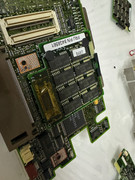
This is the spacer only found in the 755CD: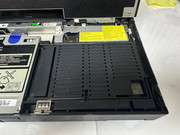
If you look at the shield over the system board(s), though, you'll see that the innards are at normal height, but for the upstand at the back increased - is that green/white bit the switch so it knows when the keyboard is lifted? That would need to be higher to touch still, like the volume wheel projecting higher.
And here is my 'restored' machine. It's not exactly perfect - mainly because the plastic on these machines doesn't get brittle but the coating does not fare well.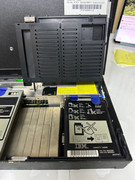
Here is the difference in thickness between the 755CD on the right and a 755C on the left: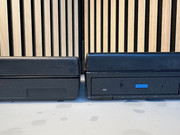
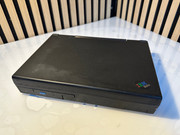
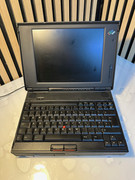
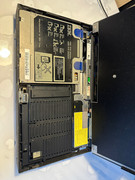
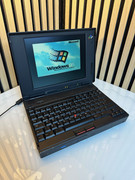
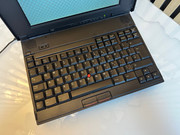

The internals of the 755CD is made up of about 5 different boards sandwiched together with the CPU attached to a wide flat heatsink right at the bottom. Each layer above that has a variety of surface mount caps which were all a bit dodgy and I replaced with ceramics. About 20 in total, including a couple of through-hole caps on one of them.
The LCD as well had 3 surface mounted electrolytics - the type that are harder to spot initially because they're encased sideways inside a plastic box. I replaced them too because the screen was a bit flickery.
Note the keyboard, trackpoint and mouse buttons do not run off their own unique seperate interposer board and instead are combined into the large multimedia chipset card on the top of all the sandwiched boards.
One aspect that slowed me down was that the audio board (with the rolling volume control) has about 5 surface mounted caps and one of them pulled the pad off. I managed to botch wire the missing pad but then decided to swap it with a spare audio which looks visibily the same which did not need the botch. Then after re-assembling I noticed that due to the whole chassis being taller, they'd made the whole stand which the volume wheel sits on about 5mm taller! So I then had to desolder both wheels and switch them.
I upgraded the P75 variant machine with a 32Mb non-parity IC DRAM card, giving 40Mb RAM and a clean installation of Windows 95. Drivers were a pain to get from a variety of breadcrumbs around dead links on the internet - but they are there. Obviously I had to use the 755CX monitor/display settings as it was now a SVGA machine.
I tried to use the archive.org ISO of the original restore CD (which would have brought back a dual boot OS2/Win3.1 installation on a 320Mb partition, but despite considerable resources it wouldn't work. You have the option to use the built-in CD-ROM but you are required to use a floppy boot disk - but obviously you can only have one in the drive bay at once, and you can't hot swap. Usually this would be no problem as the 755CD does have an external FDD connector but it's unlike almost every other thinkpad I've seen. It's small and fat and I couldn't find that cable anywhere.
So the alternative was to boot using a massive Selecta Dock II, which has a built-in CD-ROM drive, which I have and I tried using but it would not detect the CD-ROM drive in the dock.
I also tried copying the files from the boot floppy to the HDD and then running those from a bootable HDD, with the built-in CD-ROM to work but no-go - the bootable floppy uses some hidden magic formula that only IBM know about so you definitely need both.
Still Windows 95 looks rather 'charming' on this machine and it would have been the obvious 'upgrade' for most owners to make. And all the drivers are there so. Yeah.
Oh and for some reason, only the right speaker works. Kinda annoying but we can't exactly allow perfection to be our enemy here.
Anyway, this is the only 755CD I've ever come across. I'm sure they aren't that rare but some of them did burn up on MIR's re-entry, so a few less.
The 755CD actually incorporates TWO of those little green & white switches to know when they keyboad is raised - the second one sits ontop of the first one (first one found in all the other 755CDs) keeping the first one pressed down and, my guess was replacing it at a higher level. Quite Heath Robinson, but it works.
From memory, the aluminium cage that surrounds most of the innard is different on the 755CD to all the others too. In other words, on all the other 755 machines the interposer for the LCD is just a 'dumb' looking riser, but on the 755CD it's a huge PCB, covered in big fat chips taking up the whole top of the chassis.
Update - the 486 DX4 variant...
The 755CD came in both 486 DX4 100Mhz and Pentium 75Mhz variants. The Pentium one is more common. The 486 had a 9545-9Bx designation and the P75 had 9545-FBx designation.
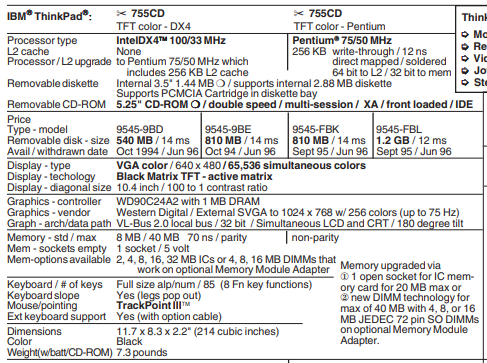
Couple of new notes... 201 Error on Boot
So, I was trying to restore a second 755CD - this time a rarer 486 DX4 100 version. The first issue was that it would not turn on and just blink some of the indicator LEDs at me. This was resolved by taking it all apart and recapping 3 of the daughterboards inside - each has about 2-6 different electrolyics onboard - mainly surface mount. Recapping solved this and the machine would boot. Then it started throwing a 201 error at me - which is described as a 'memory error'. And sometimes it is, but in this case it was not. Turns out I had exposed perhaps a glitch in the 486 755CD by replacing the CMOS battery and then doing something to cause this 201 error - which mostly seemed to be using a hard drive which had been working in another 755 variant. Once it got the 201, it could not be cleared without removing the power and the CMOS battery - at which point, it would disappear and we could do what we want.
Anyway - for anyone out there with a 201 error on a 755CD, I would suggest removing your IC DRAM card, removing your hard drive and removing your CMOS battery - leave it unplugged for a minute and then try again. If whatever you're doing keeps occasionally throwing the 201 just keep the CMOS battery out until you've sorted the issue with the hard drive, because cold booting the machine will almost always clear the 201.
Other things I noticed about the 486 version was that it would not take the newer, bigger, cheaper non-parity IC DRAM memory cards. It wants parity IC DRAM, so I managed to upgraded the RAM but only to 12Mb total (8Mb IC DRAM and 4Mb onboard).
Obviously now that the CD-ROM drive was standard, booting with a floppy to FDISK and re-MBR the hard drive was a problem and the floppy connector is fairly unusual for thinkpads... This was the first thinkpad with a built-in CD-ROM so I guess they decided to come up with their own short-term standard rather than use a connector from a 2xx or 5xx machine which also would have not had an in-built floppy drive...
The easiest thing to do is to borrow an internal floppy from virtually any other 755 machine and it will use the same connector as the internal CD-ROM drive. It just won't look so pretty!
The 755CD 486 didn't like using hard drives from other 755 machines. I suspect the 486 motherboard has a different IDE bus. So being able to re-initialise a drive on the same hardware is quite important. I did have some success taking a hard drive for a 755CX then just doing an FDISK /MBR on it.
Here is the 755CD Pentium 75 on the left (with CX/upgraded SVGA panel) and 486 DX4 100 on the right:



